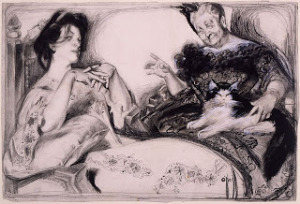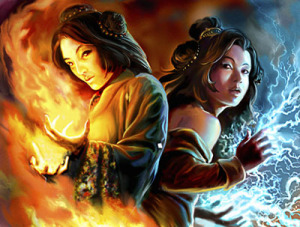Lee Moyer offers his useful guidance to would be or practicing artists trying to gt their break in the world of commercial art…
I critique hundreds of pieces every year. Not because I’m a Creative Director (although I have been), but because I (like you) am a consumer of art – of illustration, painting, comics, games, et alia. And the act of critique is one of the most helpful for enlarging one’s own understanding and formalizing concepts that might otherwise float away…
While the following list is by no means scientific (many of the elements listed below overlay others, and many great paintings use only a few) I made it for my own reference and I hope it will be food for thought.
Print it out and put it by your drafting table or computer if it’ll help.
Focus
Where do you want your viewer’s eye to go? What’s the heart of the piece, the crux of the biscuit?
Composition and Design
Create a visual hierarchy – A path for the viewer to follow? Something fractal? Separate elements intended for book cover, spine and back cover? Consider the surface you’re working on, its aspect ratio and how that effects the harmonies and tensions of your piece. When working in a tall oval, or a wide ceiling, or a strange milled form, that’s pretty obvious. But it is just as important within a normal rectangle.
Palette
There are many good ones that great painters have applied over the years. Use one of theirs or make your own!
Value
Can your piece be reduced to black and white and still read correctly?
Sometimes good pieces work their value in terms of warm and cool colors, but most need strong tonal variety to read well.
 |
| Signs by Rosie O’Neill. |
Mass
Think Rodin, JC Leyendecker or Rose O’Neill.
Texture
It makes things and people seem real.
Symbolism
Personal, classical, mystical or cultural – words, numbers, objects, beings. There’s no shortage of sources or end to interpretation as Michael Kaluta and Brian Despain are good examples.
Synecdoche (Micro defining Macro)
A small area of tight or implied detail will help define vast shapes – like the windows in a colossal building or the wrinkles on an elephant. One needs the wee bits for versimilitude…
Ornament
Whether it’s Mary Engelbreit‘s checkerboards, or Stephen Hickman‘s ornate orientalism, Ornament matters. Sometimes it’s a sort of texture, other times the whole raison d’etre.
Narrative
Is there a story here? A big idea? A paradigm, a parody, a pastiche? Has the sword been nicked in battle, has the dog been fed, has the sweater been patched? Norman Rockwell began his pictures thinking of a soldier under a light post and ran scenarios in his mind (often switching “lead” characters) until he found a painting.
Juxtaposition
Comparisons and contrasts of size, scope, meaning, characters… in our world of Zoroastrian black and white contrasts, this is often too-easy. Use discretion and variety.
 |
| Hunt for Adventure art by Glenn Orbik |
Stylization
Sometimes it’s fetishism for a type of brush-stroke or color scheme, sometimes caricature or anatomy. For example, the best pin-ups (by Gil Elvgren, Aly Fell, Glen Orbik, et alia) have similarly stylized elements, some of which might surprise you.
If you’re working on a pin-up, just crack their code and you’re off to the races.
Character
Have the characters lived real lives? Are they real beings with hopes and fears? Body language, gesture and costume are crucial here.
Tension
Gesture is important, but so is the feeling of tension. Sometimes it’s the most important part of a piece. Drama, high stakes, suspense. If you can enlist the viewer’s sympathy support or curiosity, you win.
Line
It’s quite obvious in the works of Franklin Booth, Aubrey Beardsley, and Mike Mignola – but don’t underestimate its importance for Drew Struzan, Arthur Rackham or John Jude Palencar.
Research/Reference
I know precious few people who draw brilliantly out of their heads, but those heads have absorbed the lessons their eyes have shown them for many years. Most of us have been nowhere near as observant, and while we may remember and be able to imagine many things, there are usually areas where we fall down. Bolster yourself and your work with reference. Don’t stick slavishly to it, but make it do your bidding.
Vignette
The play of shape (whether silhouette or fully rendered form) against a white, colour, or fully realized background is so important for keeping a viewer interested.
Perspective
Each point in perspective applies to a single dimension (in 2 point perspective the points are nearly always width and depth). Get perspective right and you’ll be halfway home. Also, the more you keep you POV away from a normal grid as seen from 6′, the more dynamic your piece will be.
FUN!
A certain joie de vivre is key. It doesn’t matter if you paint supplely or with technical perfection – If you don’t bring some fun and adventure to your work, viewers can tell. They won’t always know what’s wrong, but they’ll get that something is…
To which list the delightful Kurt Huggins suggested:
Process: This is your way of managing and editing all of these different elements. Each step of your process should be about solidifying one more element of the image, building up to a final piece. There are many processes, and many ways to finish, but I think most processes start with idea or composition.
• More of Lee’s work at www.leemoyer.com
• Read our interview with Lee Moyer
This article © 2008 Lee Moyer. Used here with permission
The founder of downthetubes, which he established in 1998. John works as a comics and magazine editor, writer, and on promotional work for the Lakes International Comic Art Festival. He is currently editor of Star Trek Explorer, published by Titan – his third tour of duty on the title originally titled Star Trek Magazine.
Working in British comics publishing since the 1980s, his credits include editor of titles such as Doctor Who Magazine, Babylon 5 Magazine, and more. He also edited the comics anthology STRIP Magazine and edited several audio comics for ROK Comics. He has also edited several comic collections, including volumes of “Charley’s War” and “Dan Dare”.
He’s the writer of “Pilgrim: Secrets and Lies” for B7 Comics; “Crucible”, a creator-owned project with 2000AD artist Smuzz; and “Death Duty” and “Skow Dogs” with Dave Hailwood.
Categories: British Comics

 Portsmouth Comic Con announces 2024 Talent Search
Portsmouth Comic Con announces 2024 Talent Search  Strawjack – The Terror of Romney Marsh by Keith Page, Part 2
Strawjack – The Terror of Romney Marsh by Keith Page, Part 2  Exclusive: SF thriller “Pilgrim: Secrets and Lies” continues at B7 Comics
Exclusive: SF thriller “Pilgrim: Secrets and Lies” continues at B7 Comics  Rebellion Releases: “Brink” is back in 2000AD, new Judge Dredd Megazine hist stores
Rebellion Releases: “Brink” is back in 2000AD, new Judge Dredd Megazine hist stores